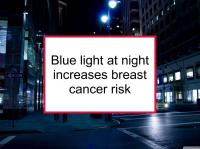Exposure to light at night is associated with increased risk of breast cancer and its recurrence. Night shift work has been linked to heightened risk; the degree of increased risk appears to be related to the number of consecutive night shifts worked. Occasional night shifts, even over of a period of decades, appears to have little influence on risk.
The above finding regarding night shift work appears to indicate that extended exposure to bright light at night drives breast cancer risk. However, more recent studies have reported that ongoing night time exposure to dim light or small but bright sources of light (especially blue light) also increase risk. Now a new study has reported that exposure to blue outdoor light at night appears to increase both breast cancer risk in women and prostate cancer in men.
Exposure to light at night disrupts melatonin production
Melatonin is a hormone that communicates information concerning available light to various organs. Melatonin is produced at night (or in conditions of darkness) and nocturnal light disrupts melatonin synthesis. Blue light wavelengths appear to have a far greater suppressive effect on melatonin production than red wavelengths. Melatonin is known primarily for its involvement in the regulation of circadian rhythms. However, melatonin has also been shown to have antioxidant, anti-inflammatory, and anti-carcinogenic properties, especially in breast cancer.
Research links exposure to blue outdoor light to breast cancer
The study referenced above was designed to investigate the links between exposure to light at night and risks of breast and prostate cancer (another hormone-dependent cancer) among people who have never worked at night. The 2008 to 2013 study included 1,219 women with breast cancer, 1,385 cancer-free female controls, 623 men with prostate cancer, and 879 cancer-free male controls from 11 regions in Spain. Data concerning exposure to indoor light at night was obtained using questionnaires.
The authors also used images from the International Space Station (ISS) for Barcelona and Madrid to analyze outdoor light at night. This data, which was only available for 2012-2013, included information concerning both remotely sensed upward light intensity and blue light for the longest period of residence of eligible participants.
Among study participants with available data concerning both indoor and outdoor light at night, exposure to outdoor right at night in the blue light spectrum was found to be associated with significantly increased risk of breast cancer among women and prostate cancer among men. However, participants who were exposed to the highest intensity of outdoor light at night were more likely to be controls than cancer cases, especially for prostate cancer. Men who reported sleeping in “quite illuminated” bedrooms had a higher risk of prostate cancer compared with those who slept in total darkness. On the other hand women had a slightly lower risk of breast cancer.
The authors conclude that both prostate and breast cancer were associated with high exposure to outdoor light at night in the blue-appearing portion of the visible spectrum.
Please see the tag circadian rhythms for more information.
